In a troubling trend uncovered over the past decade, school crossing guards across the United States have faced significant risks on the job, with hundreds injured and dozens killed while directing traffic for schoolchildren. These essential workers often stand alone in busy intersections, facing distractions from hurried drivers.
According to an investigation by AP and Cox Media Group, around 230 crossing guards were struck by vehicles across 37 states and the District of Columbia. Nearly three dozen of those guards died as a result of their injuries. However, a comprehensive understanding of the scope of this issue is complicated by a lack of national tracking systems and inconsistent state records.
Data from the investigations shows that nearly half of the drivers who hit crossing guards were cited for traffic violations, while others faced either no charges or minimal consequences. Many collision reports fail to distinguish crossing guards as victims, leading to underrecognition of their vulnerability.
As Anthony Taylor, a crossing guard who survived a severe accident, noted, “I like what I do, and I enjoy being around the public.” This sentiment echoes through the stories of many crossing guards, who love their work despite the risks and continue to advocate for safer laws and greater public awareness.
Experts suggest that solutions such as implementing smart crosswalks, increasing police presence in school zones, and improving vehicle safety standards could significantly enhance guard safety. The community also calls for increased traffic citations for reckless behavior through school zones to discourage harmful driving habits.
While the federal government has failed to create specific safety standards or tracking systems for crossing guards, two states, New Jersey and Massachusetts, have begun taking measures to improve conditions for these workers, offering hope for broader reforms in the future. The ongoing vulnerability of school crossing guards highlights the urgent need for greater protections to ensure their safety on the roads.























